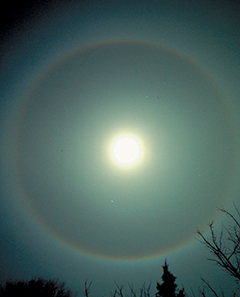24.6 Predicting the Weather
Reading Focus
Key Concepts
 What technologies help meteorologists predict the weather?
What technologies help meteorologists predict the weather? How do meteorologists show information on weather maps?
How do meteorologists show information on weather maps?
Vocabulary
meteorologists
isotherm
isobar
Reading Strategy
Identifying the Main Idea Copy the table below. As you read the text, write the main idea for each topic heading.
Heading |
Main Idea |
Weather forecasting |
a. |
Weather maps |
a. |
Figure 27 Moonlight reflecting off ice crystals in cirrostratus clouds can cause a halo to appear around the moon. Such a halo often indicates that precipitation is on the way.

An old folk rhyme includes this line: “The moon in halos hid her head….” The rhyme suggests that a halo around the moon is a sign that rain or snow should be expected. This bit of folk wisdom has some scientific validity. When you see a halo around the moon, what you're seeing is moonlight shining through cirrostratus clouds. Because cirrostratus clouds often move in before storm clouds, a halo around the moon might indeed indicate precipitation in the near future.
Now consider another bit of weather wisdom from long ago: If a cat scratches itself while sitting on a fence, expect rain before night. Would you look for rain if you saw a cat do that? Probably not. That's the trouble with folk wisdom. Some of it makes sense, and some of it doesn't. Luckily, there are now more reliable ways of forecasting the weather.
Weather Forecasting
The study of Earth's atmosphere is called meteorology. Meteorologists (mee tee uh RAWL uh jists) are scientists who study weather.  Meteorologists use many technologies to help predict the weather, including Doppler radar, automated weather stations, weather satellites, and high-speed computers.
Meteorologists use many technologies to help predict the weather, including Doppler radar, automated weather stations, weather satellites, and high-speed computers.
Doppler Radar
Doppler radar is a technology based on use of the Doppler effect. Recall from physics that the Doppler effect is the apparent change in frequency of waves as either the source of the waves moves or the observer moves. Doppler radar works by bouncing radio waves off particles of precipitation in moving storms and then measuring the frequency of the waves that return.





